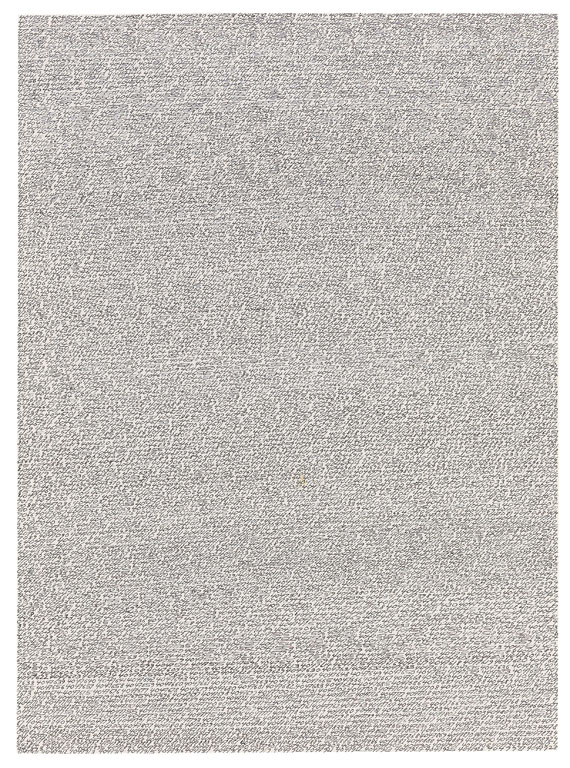Property from the Collection of an Important European Collector Roman Opałka Follow OPAŁKA 1965/1 – ∞ DETAIL 4514079 - 4536373 titled '"OPALKA 1965/1 – ∞ DETAIL 4514079 - 4536373"' on the reverse acrylic on canvas 196.5 x 135.2 cm (77 3/8 x 53 1/4 in.) Conceived in 1965, this work will be included in the Roman Opalka Catalogue raisonné currently under preparation by Michel Baudson under number D430.
Provenance Gallery Thomas Zander, Cologne Acquired from the above by the present owner in 2012 Catalogue Essay The present work by Roman Opałka OPAŁKA 1965/1 – ∞ DETAIL 4514079 - 4536373 , is the result of one of the most profoundly existential projects in the canon of twentieth-century art history. Minute white numerals on a near-white canvas, place the present work amongst the Franco-Polish conceptual artist’s ‘details’. Opałka sought to visualise, through his extensive ‘Infinity’ series, the irreversible succession of time. A testimony to a rigorous and unwavering pursuit, the artist’s enduring legacy, DETAIL 4514079 - 4536373, is an abiding testament to the artist whose life became his art, and his art, his life. In an approach which is at once ritualistic and obsessive, Opałka awoke each day to count and paint, paint and count. Not simply seeking to capture measureable time – time as ‘told’ by the clock – Opałka aimed to ‘show’ lived-time. Visually, the effect is one of a dizzying and complex patterns akin to a digital code or cryptogram. An endless stream of numbers, delimited, painstakingly, by hand using a ‘no. 0’ brush – a size which he never varied. The inspiration for this all-encompassing project was realised in 1965, whilst the artist was waiting for his wife in a café. Concerned with the lack of direction in his earlier Chronomes series, the artist decided to change his dots to numbers, initiating this momentous opus. In 1968, Opałka changed the background colour of his canvases to grey. Following this, in 1972 the artist gradually began adding 1 percent more white pigment to the ground colour, steadily moving towards a white background. This elicited a sense of ‘invisibility’, as the numbers and ground of the artist’s began to blend almost entirely, signaling his own physical aging. Pure white, which Opałka coined ‘blanc mérité’, ‘well-earned white’, was achieved in 2008. The dimensions of each canvas, measuring 196 x 135cm, corresponded to the size of Opałka's studio door – evidence of the artist’s commitment to creating a sense of cohesion and totality. Adding further dimension to his project, the artist recorded, in his native Polish, the numbers he was painting and accompanying certain ‘details’ with photographs of himself before and after the completion of the canvas. The artist thus recorded his own human degeneration alongside the never-ending potential of his infinite project. Opałka’s series coincided with the movements of Minimalism and Pop Art, forming part of a broader reconsideration of the art-object which took place throughout the 1960’s. The affinity between the artist’s sequential canvases and Agnes Martin’s large-scale geometric arrangements is absolute. With its gridded compositional structure, Martin’s Untitled #4 , 1989, conveys an immensity analogous to DETAIL 4514079 - 4536373 . Just as pale gradations of colour are utilised by Martin to convey a sense of regeneration and continuum, Opałka’s numbers document the incessant linearity of time. The present work is a testament to Opałka’s sacrificial artistic venture; a program which the artist himself defined as ‘nonsensical’: ‘…this existence makes no sense; it is nonsense. And this nonsense is my work’ ('Roman Opałka: TIME', Text as presented during the symposium Time at Arti et Amicitiae in Amsterdam, The Netherlands, 15 June 2007). Echoing the sentiments of the mid twentieth century ‘Theatre of the Absurd’, like Martin’s, Opałka’s own work descends into the ultimate end: silence. Opałka makes reference, for example, to the repetitive nothingness of Samuel Beckett’s Waiting for Godot : ‘…one day we were born, one day we shall die, the same day, the same second, is that not enough for you?’ With this in mind, the Infinity series is an extensive, modern-day memento mori . Yet, at the same time, the artist’s practice is a celebration in humanity’s capacity to understand the brevity, and thus significance, of each passing moment. In 2009, in r
Property from the Collection of an Important European Collector Roman Opałka Follow OPAŁKA 1965/1 – ∞ DETAIL 4514079 - 4536373 titled '"OPALKA 1965/1 – ∞ DETAIL 4514079 - 4536373"' on the reverse acrylic on canvas 196.5 x 135.2 cm (77 3/8 x 53 1/4 in.) Conceived in 1965, this work will be included in the Roman Opalka Catalogue raisonné currently under preparation by Michel Baudson under number D430.
Provenance Gallery Thomas Zander, Cologne Acquired from the above by the present owner in 2012 Catalogue Essay The present work by Roman Opałka OPAŁKA 1965/1 – ∞ DETAIL 4514079 - 4536373 , is the result of one of the most profoundly existential projects in the canon of twentieth-century art history. Minute white numerals on a near-white canvas, place the present work amongst the Franco-Polish conceptual artist’s ‘details’. Opałka sought to visualise, through his extensive ‘Infinity’ series, the irreversible succession of time. A testimony to a rigorous and unwavering pursuit, the artist’s enduring legacy, DETAIL 4514079 - 4536373, is an abiding testament to the artist whose life became his art, and his art, his life. In an approach which is at once ritualistic and obsessive, Opałka awoke each day to count and paint, paint and count. Not simply seeking to capture measureable time – time as ‘told’ by the clock – Opałka aimed to ‘show’ lived-time. Visually, the effect is one of a dizzying and complex patterns akin to a digital code or cryptogram. An endless stream of numbers, delimited, painstakingly, by hand using a ‘no. 0’ brush – a size which he never varied. The inspiration for this all-encompassing project was realised in 1965, whilst the artist was waiting for his wife in a café. Concerned with the lack of direction in his earlier Chronomes series, the artist decided to change his dots to numbers, initiating this momentous opus. In 1968, Opałka changed the background colour of his canvases to grey. Following this, in 1972 the artist gradually began adding 1 percent more white pigment to the ground colour, steadily moving towards a white background. This elicited a sense of ‘invisibility’, as the numbers and ground of the artist’s began to blend almost entirely, signaling his own physical aging. Pure white, which Opałka coined ‘blanc mérité’, ‘well-earned white’, was achieved in 2008. The dimensions of each canvas, measuring 196 x 135cm, corresponded to the size of Opałka's studio door – evidence of the artist’s commitment to creating a sense of cohesion and totality. Adding further dimension to his project, the artist recorded, in his native Polish, the numbers he was painting and accompanying certain ‘details’ with photographs of himself before and after the completion of the canvas. The artist thus recorded his own human degeneration alongside the never-ending potential of his infinite project. Opałka’s series coincided with the movements of Minimalism and Pop Art, forming part of a broader reconsideration of the art-object which took place throughout the 1960’s. The affinity between the artist’s sequential canvases and Agnes Martin’s large-scale geometric arrangements is absolute. With its gridded compositional structure, Martin’s Untitled #4 , 1989, conveys an immensity analogous to DETAIL 4514079 - 4536373 . Just as pale gradations of colour are utilised by Martin to convey a sense of regeneration and continuum, Opałka’s numbers document the incessant linearity of time. The present work is a testament to Opałka’s sacrificial artistic venture; a program which the artist himself defined as ‘nonsensical’: ‘…this existence makes no sense; it is nonsense. And this nonsense is my work’ ('Roman Opałka: TIME', Text as presented during the symposium Time at Arti et Amicitiae in Amsterdam, The Netherlands, 15 June 2007). Echoing the sentiments of the mid twentieth century ‘Theatre of the Absurd’, like Martin’s, Opałka’s own work descends into the ultimate end: silence. Opałka makes reference, for example, to the repetitive nothingness of Samuel Beckett’s Waiting for Godot : ‘…one day we were born, one day we shall die, the same day, the same second, is that not enough for you?’ With this in mind, the Infinity series is an extensive, modern-day memento mori . Yet, at the same time, the artist’s practice is a celebration in humanity’s capacity to understand the brevity, and thus significance, of each passing moment. In 2009, in r













.jpg)
.jpg)
Try LotSearch and its premium features for 7 days - without any costs!
Be notified automatically about new items in upcoming auctions.
Create an alert